The Incidents in the Baltic Sea
On November 18, 2024, two undersea cables were severed under circumstances that are yet to be fully understood. The first, a cable connecting Lithuania and Sweden, was cut near the Lithuanian coast. This disruption affected about a third of Lithuania’s internet capacity, although service has since been restored. The second, the C-Lion1 cable linking Finland and Germany, also experienced damage. This cable is a crucial communication line, spanning 1,200 kilometers and serving as Finland’s only direct connection to Central Europe.

Recent disruptions to two undersea internet cables in the Baltic Sea have yet again highlighted a pressing issue for businesses worldwide: the vulnerabilities inherent in our global communications infrastructure. These incidents, occurring amid heightened geopolitical tensions and fears of hybrid warfare, serve as a wake-up call for companies to reevaluate their approach to network resilience.
The Incidents in the Baltic Sea
On November 18, 2024, two undersea cables were severed under circumstances that are yet to be fully understood. The first, a cable connecting Lithuania and Sweden, was cut near the Lithuanian coast. This disruption affected about a third of Lithuania’s internet capacity, although service has since been restored. The second, the C-Lion1 cable linking Finland and Germany, also experienced damage. This cable is a crucial communication line, spanning 1,200 kilometers and serving as Finland’s only direct connection to Central Europe.

The Broader Implications
These incidents are not isolated. The U.S. and European countries have previously reported increased foreign activity near undersea cables, signaling potential risks of sabotage. Such vulnerabilities are not just geopolitical issues; they are business-critical concerns.
Undersea cables carry an estimated 95% of global internet traffic, making them the backbone of modern communications. When these cables are disrupted, businesses dependent on uninterrupted connectivity face risks including:
- Data Transmission Delays: Disruptions can cause significant latency, affecting real-time applications like video conferencing, stock trading, and cloud services.
- Service Interruptions: Companies reliant on single pathways may face outages, leading to lost productivity and revenue.
- Cybersecurity Risks: Damaged or compromised cables could expose sensitive data to malicious actors.
Strengthening Business Networks
To mitigate these risks, businesses must adopt strategies to diversify and secure their connectivity. One critical approach is multihoming, which involves connecting to multiple Internet Service Providers (ISPs).
Benefits of Multihoming:
- Redundancy: If one link fails, traffic is automatically rerouted through other connections, ensuring service continuity.
- Load Balancing: Optimizes traffic distribution across multiple ISPs, enhancing performance.
- Resilience Against Disruptions: Reduces reliance on any single pathway, minimizing the impact of cable failures or geopolitical threats.
While multihoming provides a certain layer of resilience, it requires sophisticated management to maximize its effectiveness. This is where intelligent routing solutions become essential.
The Role of Intelligent Routing with Noction IRP
Noction’s Intelligent Routing Platform (IRP) is designed to optimize and automate traffic management in multihomed networks. By continuously monitoring network conditions, Noction IRP ensures businesses can quickly adapt to disruptions like those in the Baltic Sea.
Key Features of Noction IRP:
- Real-Time Monitoring:Identifies performance degradation or outages in ISP links and takes corrective action immediately.
- Automated Route Optimization: Dynamically selects the most efficient paths for traffic, reducing latency and packet loss.
- Cost Efficiency: Balances traffic across ISPs to minimize costs while maintaining optimal performance.
Case in Point: In scenarios like the Baltic Sea cable disruptions, businesses using Noction IRP could have their traffic rerouted automatically through alternative pathways, avoiding service interruptions and maintaining productivity.
Lessons for Business Leaders
The Baltic Sea incidents underline a critical truth: the stability of global networks can no longer be taken for granted. As geopolitical tensions rise and hybrid warfare becomes a reality, major players at the global level discuss protective measures. Businesses, however, must act now to prioritize network resilience.
- Invest in Multihoming: Diversify ISP connections to build redundancy.
- Adopt Intelligent Routing Solutions: Tools like Noction IRP ensure seamless adaptation to network disruptions.
- Monitor Geopolitical Risks: Stay informed about potential threats to critical infrastructure in your operational regions.
The incidents in the Baltic Sea remind us that resilience is not a luxury; it is a necessity.










